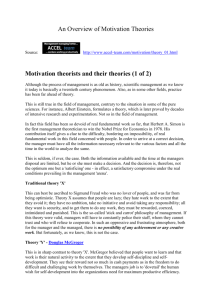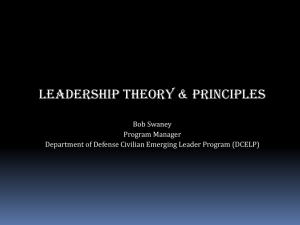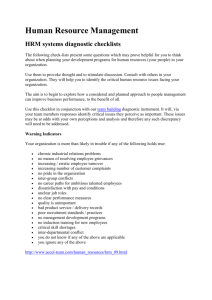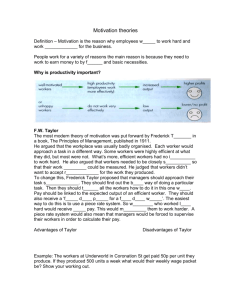Chapter 6
advertisement
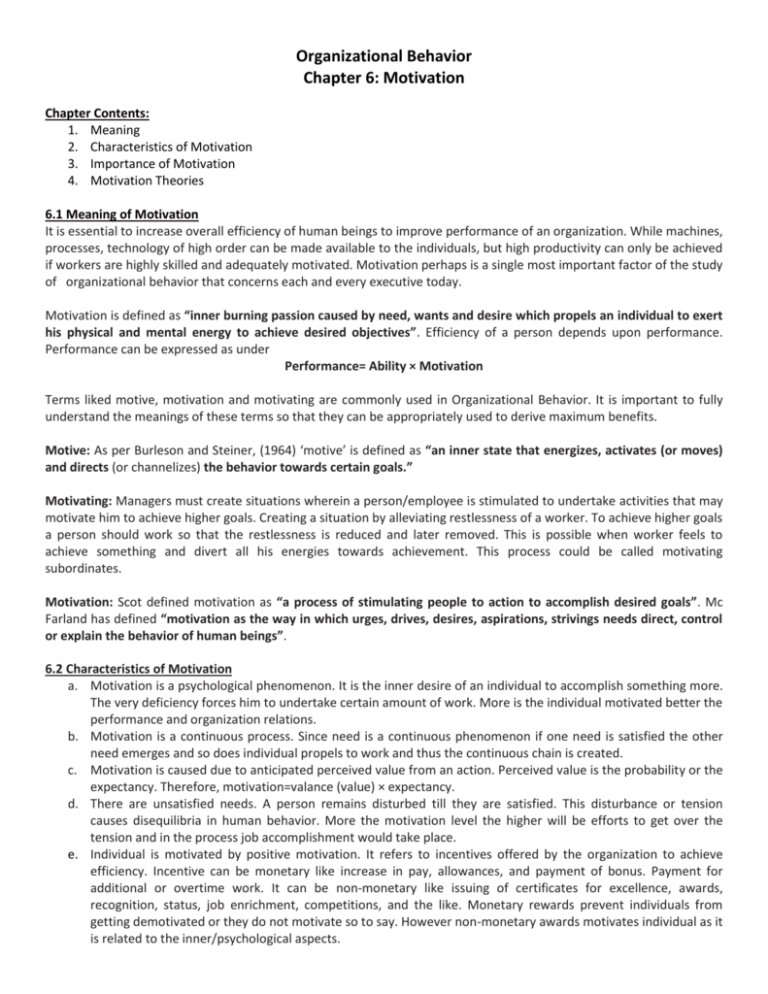
Organizational Behavior Chapter 6: Motivation Chapter Contents: 1. Meaning 2. Characteristics of Motivation 3. Importance of Motivation 4. Motivation Theories 6.1 Meaning of Motivation It is essential to increase overall efficiency of human beings to improve performance of an organization. While machines, processes, technology of high order can be made available to the individuals, but high productivity can only be achieved if workers are highly skilled and adequately motivated. Motivation perhaps is a single most important factor of the study of organizational behavior that concerns each and every executive today. Motivation is defined as “inner burning passion caused by need, wants and desire which propels an individual to exert his physical and mental energy to achieve desired objectives”. Efficiency of a person depends upon performance. Performance can be expressed as under Performance= Ability × Motivation Terms liked motive, motivation and motivating are commonly used in Organizational Behavior. It is important to fully understand the meanings of these terms so that they can be appropriately used to derive maximum benefits. Motive: As per Burleson and Steiner, (1964) ‘motive’ is defined as “an inner state that energizes, activates (or moves) and directs (or channelizes) the behavior towards certain goals.” Motivating: Managers must create situations wherein a person/employee is stimulated to undertake activities that may motivate him to achieve higher goals. Creating a situation by alleviating restlessness of a worker. To achieve higher goals a person should work so that the restlessness is reduced and later removed. This is possible when worker feels to achieve something and divert all his energies towards achievement. This process could be called motivating subordinates. Motivation: Scot defined motivation as “a process of stimulating people to action to accomplish desired goals”. Mc Farland has defined “motivation as the way in which urges, drives, desires, aspirations, strivings needs direct, control or explain the behavior of human beings”. 6.2 Characteristics of Motivation a. Motivation is a psychological phenomenon. It is the inner desire of an individual to accomplish something more. The very deficiency forces him to undertake certain amount of work. More is the individual motivated better the performance and organization relations. b. Motivation is a continuous process. Since need is a continuous phenomenon if one need is satisfied the other need emerges and so does individual propels to work and thus the continuous chain is created. c. Motivation is caused due to anticipated perceived value from an action. Perceived value is the probability or the expectancy. Therefore, motivation=valance (value) × expectancy. d. There are unsatisfied needs. A person remains disturbed till they are satisfied. This disturbance or tension causes disequilibria in human behavior. More the motivation level the higher will be efforts to get over the tension and in the process job accomplishment would take place. e. Individual is motivated by positive motivation. It refers to incentives offered by the organization to achieve efficiency. Incentive can be monetary like increase in pay, allowances, and payment of bonus. Payment for additional or overtime work. It can be non-monetary like issuing of certificates for excellence, awards, recognition, status, job enrichment, competitions, and the like. Monetary rewards prevent individuals from getting demotivated or they do not motivate so to say. However non-monetary awards motivates individual as it is related to the inner/psychological aspects. 6.3 Importance of Motivation a. High level of performance: It is the duty of every manager to ensure that the employees have a high degree of motivation. He should offer monetary and non-monetary incentives. Highly motivated workers would be regular for work, and have a sense of belonging for the organization. Quality of product will be improved, wastage will be minimum and there will be increase in productivity, and performance level will be high. b. Low employee turnover and absenteeism. Employee turnover and absenteeism is caused due to low level of motivation on the part of managers. When dissatisfaction is increased employees do not enjoy the work assigned to them. Therefore there is a tendency of absenteeism. The workers hunt for an alternative job and leave the organization whenever they get an opportunity. High level of absenteeism causes low level of production, wastages, poor quality and disruption in production schedules. Increased turnover is disastrous for any organization as it puts strain on financial position of the organization due to additional recruitment, selection, training and development. Motivation is therefore a very important management tool to achieve organizational excellence. c. Acceptance of organization change. Management must continuously scan the external and the internal environment. There has been a great impact of. Social change and technology evolution on the motivation level of employees. Social change increases aspirations of workers and put an additional demand on the organization, which must be considered positively so that conducing working environment is created. Technical innovation, better working conditions, better R & D facilities, encouragement to employees and existence of better personal policies should be part of any organization. This will facilitate retention of employees. d. Organizational image: Employees are the mirrors of any organization. Managers must lay down high performance standards coupled with high monetary and nonmonetary rewards. Training & development programs should be regularly organized and employee skill improved. It will have a positive impact on the employees and the image of the organization will be improved. It will also reduce employee turnover and better employee will look forward to join the organization. High organizational image will contribute towards brand image of the product and services the organization is marketing. 6.4 Theories of Motivation 1. Maslow’s Theory of Need Hierarchy 2. Motivation and Hygiene Two Factor Theory 3. Theory X and Theory Y 4. ERG Theory 5. Vroom’s Theory of Motivation. (Performance Satisfaction). 6. Porter — Lawler Theory. 6.4.1 Maslow’s Theory of Need Hierarchy Abraham Maslow was a clinical psychologist in USA. His motivation theory is widely accepted and studied. Maslow suggested that every individual has complex set of needs at any particular moment and his behavior is determined by the existence of strongest need. He stated that human beings have five types of needs and physiological need is the strongest hence the individual behaves in a particular manner to satisfy that need. Needs are hierarchal in nature and only one need dominates at any one point of time. Once the strongest need is satisfied then the second need emerges as being the strongest need and human behavior is regulated in process of achieving satisfaction in series of need requirements. Maslow further started that there is only one need satisfying process is underway at any one time. They do not disappear once they are satisfied but their intensity is reduced (relegated) below the subsequent need. He has arranged the needs as per Figure given below. 1. Physiological Needs - As per Maslow physiological need is strongest in every human being and hence it has highest strength as compared to the other needs. Individual behaves in a particular manner to satisfy basic bodily needs like hunger; thirst, shelter and clothing. These needs keep dominating unless they are reasonably satisfied. Human being is therefore motivated to work in that direction. 2. Safety Needs or Security Needs - Once the physiological need of an individual is satisfied, the safety need /security need arises and is dominant at that point of time. This need is related to the following:– (a) Every worker is concerned about his personal safety and wants to be free of physical danger. (b) There are various dangerous processes in the work setting. Individual desires to be free and work toward selfpreservation. (c) Safety need is also related to employee/employer relationship, which should be cordial and free from any threat to job security. (d) There should be certainty in the job and nonexistence of arbitrary action on the part of management/employer. (e) Administration policy of any organization must cover various points that are related to safety of an individual like pay, pension, insurance, and gratuity. Individual should be given opportunities for choice of job so that he derives satisfaction. He must also be given adequate security against being fired, laid off or demotion. 3. Social Needs - Once the safety need is satisfied, third need i.e. social need arises. People want to belong to some social group where their emotional need of love, affection, warmth and friendship are satisfied. Being member of sports club, social organizations or being the company of friends and relatives, needs can satisfy social. In the work setting individuals want to be member of work group and contribute towards it so that the social need of the individual is fulfilled. 4. Esteem Need or Ego Need - Fourth need in the hierarchy of needs as suggested by Maslow is Esteem need or Ego need. Individual wants self-recognition, appreciation for the work done. It is related to self-respect, self-confidence, praise, power and control. It these needs are satisfied it gives an individual a sense self-worth and ego satisfaction. 5. Self-actualization Need - Self-actualization is the last need in the need hierarchy. Once esteem need is satisfied, there appears the self-actualization need of human being. It is related to an intense carving for something supreme one wants to achieve in life. It is transcended and related to achieving the very best that may be possible of human endeavor. People set high goals, achieve them and set a higher goals again and to achieve the same by utilizing fullest potential. It is related to development of intrinsic capabilities. An individual seeking to satisfy self-actualization need seek situations or jobs that are challenging in nature - achievement of highest value out of the work. Mahatma Gandhi wanted to achieve freedom for India by unique weapons of peace and non-violence. He strived hard, faced various challenges but ultimately achieved his goal. With his innovative ideas he bound the whole nation in one thread of togetherness for the cause of freedom. In essence Maslow’s Motivational Theory covers the following. (a) There are five levels of human needs. (b) These needs are hierarchical in nature. (c) A satisfied need is no longer a need. Once that need is satisfied, the next level need becomes stronger. (d) Needs do not diminish. It is the gravity that changes. Individual strives to satisfy the need that has a strong appeal at any point of time. Analysis Maslow has taken a deprivation gratification approach to need satisfaction (Uma- Sekaran, 2000). That is, he extended that an unfulfilled or deprived need would activate a person to engage in behavior that would satisfy or gratify that need. Once one level of need is gratified, the next level of needs will emerge as the deprived needs seeking to be gratified. Relationship of various needs is given in Figure below. From the above figure, the following points emerge • Desire levels of various needs are overlapping to each other. • All needs are inter-dependent. • Each higher level need emerges before lower level need is satisfied. • Need does not disappear when it is satisfied. Its gravity is reduced when another need emerges. • When peak of a particular need is passed that need ceases to be primary and next need starts dominating. 6.4.2 Motivation and Hygiene Two Factor Theory Fredrick Herzberg and his associates developed Motivation Theory based on two main factors in late 1950’s. This theory is also known as Two Factor Theory. Herzberg carried out research in nine different organizations where 200 respondents comprising accountants and engineers were subjects. A structured interview was carried out. The purpose of the study was to identify various factors for goal achievement and also the factors that could be included so that motivation levels do not fall. Findings of the study: Herzberg concluded, “There are two types of needs, independent of each other”. (a) Motivational Factors: There is a set of job conditions, which operates primarily to build strong motivation and job satisfaction. These factors are called motivational factors. They are intrinsic in nature and help increase one’s output. These factors have positive effect on morale, productivity, and job satisfaction and overall efficiency of the organization. These factors are as under: I. II. III. IV. V. VI. Achievement Advancement Possibility of Growth Recognition. Work Itself Responsibility (b) Maintenance Factors: There are some job conditions which operate primarily to dissatisfy employees when these conditions are absent. These factors are also called hygiene factors. When these factors are present they do not motivate in a strong way, when absent they dis-satisfy, that is why these factors are called dissatisfies. These factors are. • Company Policy and administration. • Technical supervision. • Interpersonal relationship with superiors. • Interpersonal relationship with peers. • Interpersonal relationship with subordinates. • Salary. • Job security. • Personal Life. • Working condition. • Status. Above factors is not an intrinsic part of a job. They prevent losses due to work restrictions. These factors are necessary to maintain a reasonable degree of satisfaction of employees. As stated earlier they are demotivators if they are not present. For example minimum level of working conditions must be maintained by the organization to ensure that minimum level of satisfaction exists. If working conditions are poor, the employees will be dissatisfied and it would have adverse effect on goal achievement. Potency of various factors does not increase the motivational level. It is influenced by personality and characteristics of individual employee. Herzberg has identified that employees are either maintenance seekers or motivation seekers. ANALYSIS Herzberg’s Theory indicates the following: (a) It has been found that most of the people are capable of satisfying their lower level needs considerably as they are not motivated by maintenance factors/hygiene factors. (b) Any improvement in Hygiene factors do not motivate workers but their reduction below a certain level will dissatisfy them. For example increase in status or salary need not motivate an employee because he feels it, as a matter of happening but if he was not to get an increase in salary or if his status is not increased he would be dissatisfied. Hence the hygiene factors are called dissatisfiers. Therefore they do not contribute towards motivation. (c) The model suggested by Herzberg is not applicable in all conditions. There is a mixing up of both factors in a job, which cannot be separated, as intrinsic and extrinsic. Because the level of personal need and relative strength of each of the needs is different from person to person. (d) Job satisfaction and job dissatisfaction are two opposite points on a single continuum. It has been seen that individuals are affected more by job environment or job contents when we want to achieve this, what we are actually doing is keeping hygiene factors constant and increasing the motivational factors in a job like improving the work itself or having growth orientation or we delegate the job to an individual and vest in him the full authority and responsibility. (e) Herzberg’s theory of motivation is not conclusive as the scope was narrow. Only 200 respondents were interviewed and that to persons belonging to white collar jobs [engineers & accountants] hence effect of various hygiene factors may be positive on workers. (f) The study is “Method bound”. It has not shown any positive results in actual work environment. (g) Herzberg’s study of motivation is important, as it has identified two main factors as Motivational factors and Maintenance or Hygiene factors. They should not be divided in strict water tight compartments. Certain overlap is bound to happen. Since these are applied in relation to various human beings. 6.4.3 McGregor’s Theory X and Theory Y Douglas McGregor introduced Theory X and theory Y which are diagonally opposite to each other. McGregor is aware that human beings are rational in their thought process and they are social by nature. They display very high degree of behavior relating to achieving self-actualization. There is interaction of variety of need fulfillment phenomenon and complex nature displayed by an individual in different situations. Theory X Theory X is a traditional theory of human being McGregor assumed that with respect to Managerial action. Management is responsible for organizing various element of an enterprise like money, material equipment and people. With respect to people, it is a process of directing people, their efforts, motivating them, controlling their actions, modifying their behaviors so that they fit in the organizations. In Theory X McGregor assumed that people would be passive therefore management must persuade, reward and punish the worker to achieve the desired behavior of workers. Human nature –McGregor further stated that Human being have indolent nature, he works minimum. McGregor summaries workers as lacks ambition, dislike responsibility, prefers to be led. An individual is self-centered and indifferent to organizational needs, by nature he resist change. Lastly he gullible and not very bright. In theory X, McGregor states that those who subscribe to the views expressed above, the manager will have to structure, control and closely supervise employees. External control has to be exercised towards immature and irresponsible behavior of the employees, so that their energies can be regulated towards productive work. Theory X is applicable to traditional organizational and characterized by centralized decision making hierarchical pyramid and external control. After Theory X was proposed, McGregor observed that some changes in human nature have taken place. It was not due to the changes in human behavior and reactions to various situations but due to change in industrial organizations, management policies and practices that have tremendous effect on human nature. At this point he proposed. Theory Y as under: Theory Y (a) Expenditure of physical and mental efforts on the part of employees is as natural as play or rest. The average human being does not inherently dislike work. (b) Workers seek direction and exercises self-control. He dislikes punishment. (c) Commitment to organizational objective is associated with rewards like pay promotion etc., ego satisfaction and satisfaction of self-actualization needs. (d) Average human being learns under proper conditions. He accepts seeks responsibilities. At times, it will be seen that certain individuals display phenomenon like avoidance of responsibility, lack of ambition and lay undue stress on security. McGregor suggested that these are due to inherent human characteristics. (e) Capacity to exercise high degree of imagination, ingenuity and creativity is widely distributed among workers that must be identified and fully utilized. (f) Intellectual potential of workers is partially utilized. In the above situation McGregor recommends that the organization should reorient based on the human behavioral change. More co-operations, maximum output with minimum control and self-direction is predominant among workers. It is also seen that there is no conflict between individual and organizational goals. The emphasis is on very smooth running of organization with greater participation of individuals. Analysis Paul HERSEY has analyzed Theory X and Theory Y. He states that managers who accept theory X assumptions about human nature usually direct, control, and closely supervise people, whereas theory Y managers are supportive and facilitating. We want to caution against drawing such consolation because it could level to the trap of thinking that Theory X is “bad” and Theory Y is “good”. It is unusual to find exclusively Theory X people or Theory Y people in any organization. There would always be a mix of both types of employees in varying proportions. Managers therefore will have to tailor their motivational application in appropriate manner suiting behavioral patterns. 6.4.4 ERG Theory Clayton Alderfer of Yale University carried out further studies on Maslow’s theory of need hierarchy. He identified three basic needs of human being against five needs of Maslow. These are as under: (a) E-Existence need - There are related to provision of basic material requirement of human being and are related to Maslow’s Physiological and safety needs. (b) R-Relatedness - This need is related to desire of an individual to maintain sound interpersonal relationship. It is related to Maslow’s, Social need and External component of Esteem need i.e., status, recognition and attention. (c) G-Growth - Growth is an intrinsic desire for personal development. It is related to intrinsic component of Esteem Need like Evaluation (a) Alderfer advocated three need patterns of an individual as against five steps proposed by Maslow. (b) Alderfer recommends that all the needs, need not be in rigid stepwise progression. Any need may be stronger and individual is forced to fulfill that need. (c) More than one need may be operative at any one time. It gratification of higher need is stifled, the desire to satisfy lower level need may increase. ERG Theory contains a frustration — regression dimensions (when there is a frustration in higher level need, lower level needs may get more activated.) Alderfer recommends satisfaction - progression paten of need. i.e. when one level need is satisfied then higher level need arises (satisfaction-progression). 6.4.5 Expectancy Theory-Vroom Vroom has propagated Expectancy Theory based on employee expectancy. He believes that employee is motivated to exert high level of efforts when he believes that efforts will lead to good performance and therefore organizational rewards that will satisfy achievement of personal goals. The focus of the theory has three elements. (a) Efforts - Performance relationship. It is related to the probability perceived by individual that exerting a given amount of efforts will lead to performance (Expectancy). (b) Performance - Reward Relationship. The degree to which the individual believes that performing a particular level will lead to attainment of desired outcome (Instrumentality). (c) Reward-personal goal relationship. The degree to which an organizational reword will satisfy individual needs and its attractiveness for the individual (Valence). Analysis Maslow’s theory is basically need satisfying concept. Vroom has gone one step ahead to identify individual expectations from the organization, and its impact on work behavior of an individual. If a system of performance appraisal and its resultant benefits are attractive, then the individual will put up his best to achieve organizational objective. The behavior of an individual has been taken as rational. The theory helps managers to work beyond Maslow and Herzberg and create work environment and set organizational goals in such a way that individual is stretched to achieve higher performance. However the theory is difficult to implement because of the organizations inability to provided required resources and time. 6.4.6 Porter and Lawler Model of Motivation Lyman Porter and Edward Lawler came up with a comprehensive model of motivation. They combined adding two more components to Vroom’s theory of motivation. The model is more comprehensive as it includes various aspects that we have studied so far. This is a multivariate model which explain the relationship that exists between job attitudes and job performance. This model is based on four assumptions of human behavior as under: (a) Individual behavior is determined by a combination of factors that exist in the individual and are present in the environment. (b) Individuals are considered to be rationale people who make conscious and logical decisions about their behavior when they interact with other people in the organization. (c) Every individual have different needs, desires, and their goals are of varied nature. (d) On the basis of their expectations, individuals decide between alternate behaviors. The outcome of the efforts is related to the pattern of behaviors an individual display. Porter and Lawler model of motivation is explained in Figure. 1. Value of rewards. People try to find out the rewards that are likely to be received from undertaking a particular job will be attractive enough. This phenomenon is equal to that of valence in Vroom’s theory of motivation. If rewards are attractive, an individual will put in extra efforts, otherwise he will lower the very desire of doing a job. 2. Efforts. Efforts refer to the amount of energy which an individual is prepared to exert on a job assigned to him. 3. Perceived Efforts - Reward Probability. People try to assess the probability of a certain level of efforts leading to a desired level of performance and the possibility of that performance leading to rewards. Bases on the valence-reward and the efforts-rewards probability, people decide the amount of efforts they would like to put in. 4. Performance. Efforts lead to performance. The level of performance will generally depend upon role perception as defined in the standing orders/ policy instructions, the level of efforts, skills, ability, knowledge, and intellectual capacity of the individual. Traits also play a role in performance equation. Thus, ability and personality traits will moderate effortperformance relationship. Performance of the individual is directly related to reward he is likely to get. Reward is of two type i.e., intrinsic and extrinsic. Individual is generally motivated by intrinsic rewards. It is therefore necessary that the organization pay an adequate attention to the reward system in the organization. Extrinsic Rewards are in the form of money or other material elements that have been included in hygiene factors of Hertzberg’s motivation theory. 5. Satisfaction. Satisfaction results from intrinsic rewards. Individual will therefore compare his actual rewards with the perceived rewards. If actual rewards are equal or greater than perceived rewards the individual would feel satisfied. On the contrary if they are less than perceived rewards, an individual will put in reduced efforts, and obviously he will be less satisfied.


